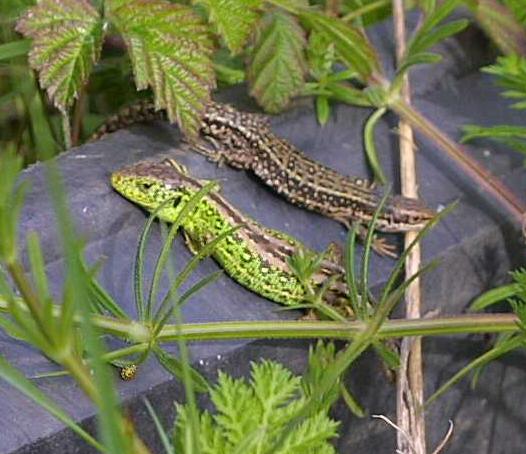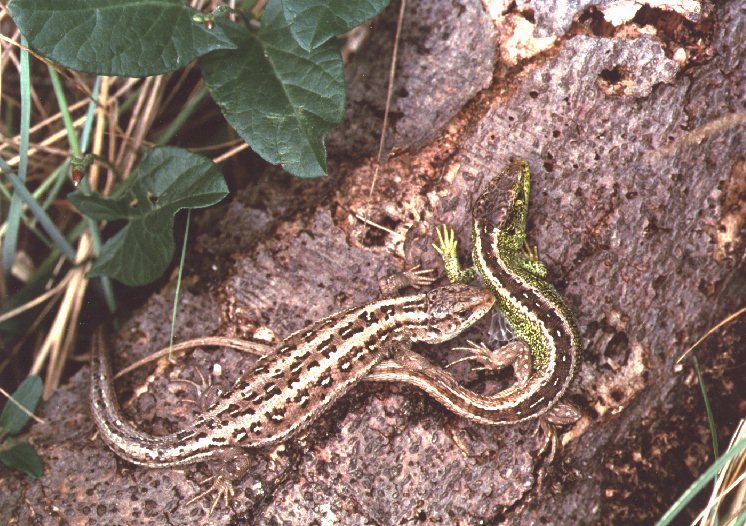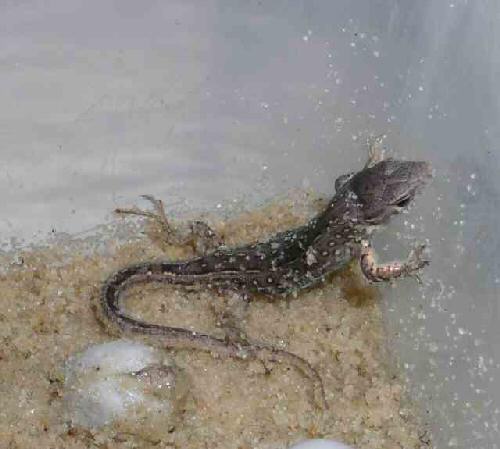
The Sand Lizard - Lacerta agilis
This is the only one of our endangered species which I am going into in any detail. The reason, simply, is that these are the animals with which I am most extensively involved and of which I can speak with some pretence to expertise.Many people think they have seen Sand Lizards simply because they have observed a lizard with a greenish tint on heathland or dunes. More often than not, however, these animals are often simply greenish coloured Viviparous Lizards. Once someone has seen an adult male Sand Lizard they never make the same mistake again.
This situation arises because most descriptions of them mention that they are 20cms long and this is only about 30-50% longer than a Viviparous Lizard. All though they are usually described as "stocky" none of this really prepares anyone for the size contrast. In practice, although they are only 30-50% longer, they are much more heavily built. Simplistically they are at least twice as wide and twice as high. This means that their mass, which is what one usually notes when observing an animal is actually about 6 times greater than a Viviparous Lizard.
In addition, Sand Lizards tend to be more noticeably marked and, particularly in the breeding season, spectacularly more colourful. Hopefully, the picture below will illustrate this. The topmost animal is a large, fully grown mature male Viviparous Lizard. The lower animal is a mature, but young and far from fully grown male Sand Lizard. As can be seen, although there is little difference in the body length of these two, it is a much large animal and, as a male in full breeding colouration there is little resemblance to the other.

Male Viviparous and Sand Lizard comparison
While the females lack the green flanks, and, indeed, these are absent from the males outside the breeding season, clearly these are a much larger animal with distinctive markings. The picture below shows an adult pair.

A pair of captive bred Merseyside Sand Lizards in my vivarium - (c) Hugh Clark
There are three distinct races of Sand Lizard within the UK, usually described by their main geographical location. These are the Dorset, Wealden and Merseyside races. The Dorset race tends to have narrower pale bands down each side of the back and more ocellations whereas in the Wealden race the pale bands are often completely absent with even more ocellations. Having said this any of these variations can appear in any of these locations. Each different marking is the most suitable for the animal's habitat and it is natural selection as well as heredity which both determines the prevalent patterns and allows the exceptions.
The key to the Sand Lizard's survival in this country is, as its name suggests, sand. This is because sand is well drained, can be easily dug and readily absorbs heat from the sun. It is thus imminently suitable for the animals to incubate their eggs in this country where they are close to their climatic extremes. It is possible, with global warming that this dependence on sand will lessen, allowing them to move into other habitats as they have in mainland Europe.
In the meantime the combination of open sand and dense vegetation they require ensures that here they are restricted to dry lowland heath and coastal dune systems - two habits which have suffered massive destruction over the years.
We are at last beginning to realise the value of these habitats and many of them are now protected and management programs are in force. Where the lizards are still found, this has enabled them to expand and achieve a relatively stable and secure status. Sadly, the previous habitat destruction means that much of what is left is now fragmented, with no naturally surviving populations and no possibility of them being colonised naturally. This is where captive breeding and translocations come into play.
Although I co-ordinate the Captive Breeding Programme, that is a relatively small role. Apart from myself there are a number of knowledgeable and committed individuals and organisations who breed animals in captivity for the programme. Through their efforts anywhere from 100 to 500 animals are released into the wild each year.
Many of these animals will, sadly, not survive but by using artificial incubation and achieving an earlier and reliable hatching by the time they are released they have already grown on substantially more than the wild animals. This means that their survival rate over the first crucial hibernation period is hugely improved. In the wild it can be as low as 5% - with these animals it can be as high as 90%.

A hatchling Sand Lizard - barely 2 inches long overall.
Using these techniques 65 introductions have taken place of which only one failed due to errors of judgement (inappropriate habitat) - and 9 cases in which there were subsequent habitat problems - mainly damage by fire. Which brings us back to the start point. However valuable the efforts of those captive breeders, the immense amounts of work that have to be put into the habitat are the real key. Without that, there would be nowhere to introduce the animals and our few surviving natural occurring colonies would be in terminal decline - if, indeed they had not already become extinct as they did in Wales before this programme restored them.
This is where YOU can help by following the links to ARC-Trust, NARRS, ARG etc.
